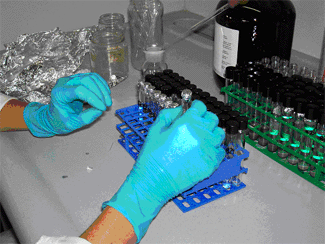Reconstructing past temperatures

Unveiling the Earth's climate history supports the comprehension of the interacting elements that determine natural climate variability and, thus, enhances our potential to predict future climate change. Climate history is registered in fossil remnants preserved in natural archives such as marine or lake sediments.
One of the methods that are currently used to reconstruct past climate is based on organic molecules, so-called biomarkers, with a molecular structure that varies according to the ambient temperature during their synthesis. This specific structure is preserved through time, even after the compounds have been incorporated into the sediments from e.g. a lake or the ocean. Thus, we can recover these "molecular fossils" from ancient sediments and estimate the environmental temperatures at a certain place and time.
In our group GEPOC (Group for the Study of Oceanic and Climatic Processes), at ICTA (Institute of Environmental Science and Technology), we study among other biomarkers some lipids present in the cell membrane of archaeabacteria, the oldest organisms known on the Earth. The analysis of these “fossil” lipids starts with the recovery of sediment cores from selected marine or freshwater sites, slicing the core downwards in thin sections to get a continuous historic record and transfer all samples to our lab. There, the lipids are isolated from the organic matter contained in the sediment. Thanks to the development of analytical techniques, we are able to separate a suite of lipids using liquid chromatography and identify them by obtaining their exact mass in a mass spectrometer.
Reconstruction of superficial water temperatures of Lake Baikal (Central Asia) from the last glacial times, with archaeabacteria lipids analysis.
In our study we report the adaptation and optimization of the method used for the analysis of the archaeabacterial lipids. Our main contribution is the reduction of the analysis time per sample, from 1 hour to 8 minutes. This allows a higher sample throughput, i.e. the number of samples that can be done given a limited amount of time and material resources, which enhances the potential of paleoclimatic studies.
The most exciting part consists in applying these - now accurate and rapid - analyses to several meters long marine or lake sediment cores and reconstruct past water temperatures. Currently, most of the samples we are working on come from Lake Baikal, in Central Siberia, one of the largest freshwater reservoirs of the world, for which we have reconstructed the temperature evolution since the last glacial times.
References
"Rapid screening of glycerol dialkyl glycerol tetraethers in continental Eurasia samples using HPLC/APCI-ion trap mass spectrometry". Escala, M; Rosell-Mele, A; Masque, P. ORGANIC GEOCHEMISTRY, 38 (1): 161-164 2007

